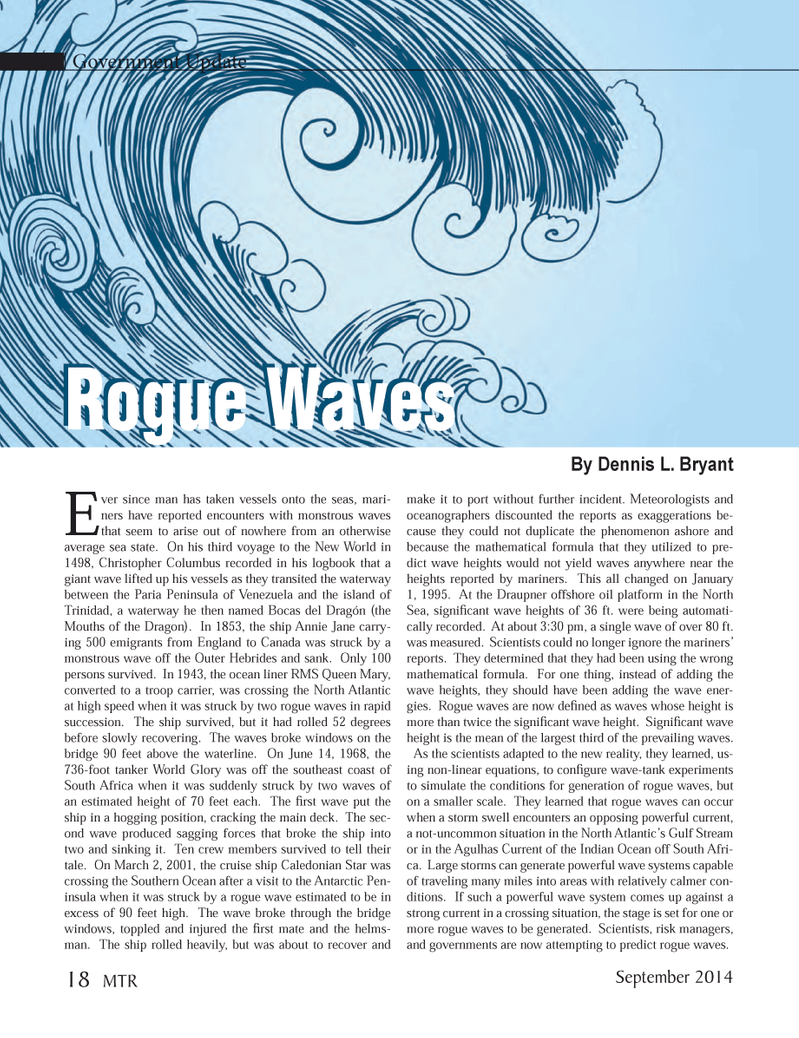
Page 18: of Marine Technology Magazine (September 2014)
Ocean Observation: Gliders, Buoys & Sub-Surface Networks
Read this page in Pdf, Flash or Html5 edition of September 2014 Marine Technology Magazine
E ver since man has taken vessels onto the seas, mari- ners have reported encounters with monstrous waves that seem to arise out of nowhere from an otherwise average sea state. On his third voyage to the New World in 1498, Christopher Columbus recorded in his logbook that a giant wave lifted up his vessels as they transited the waterway between the Paria Peninsula of Venezuela and the island of
Trinidad, a waterway he then named Bocas del Dragón (the
Mouths of the Dragon). In 1853, the ship Annie Jane carry- ing 500 emigrants from England to Canada was struck by a monstrous wave off the Outer Hebrides and sank. Only 100 persons survived. In 1943, the ocean liner RMS Queen Mary, converted to a troop carrier, was crossing the North Atlantic at high speed when it was struck by two rogue waves in rapid succession. The ship survived, but it had rolled 52 degrees before slowly recovering. The waves broke windows on the bridge 90 feet above the waterline. On June 14, 1968, the 736-foot tanker World Glory was off the southeast coast of
South Africa when it was suddenly struck by two waves of an estimated height of 70 feet each. The fi rst wave put the ship in a hogging position, cracking the main deck. The sec- ond wave produced sagging forces that broke the ship into two and sinking it. Ten crew members survived to tell their tale. On March 2, 2001, the cruise ship Caledonian Star was crossing the Southern Ocean after a visit to the Antarctic Pen- insula when it was struck by a rogue wave estimated to be in excess of 90 feet high. The wave broke through the bridge windows, toppled and injured the fi rst mate and the helms- man. The ship rolled heavily, but was about to recover and make it to port without further incident. Meteorologists and oceanographers discounted the reports as exaggerations be- cause they could not duplicate the phenomenon ashore and because the mathematical formula that they utilized to pre- dict wave heights would not yield waves anywhere near the heights reported by mariners. This all changed on January 1, 1995. At the Draupner offshore oil platform in the North
Sea, signifi cant wave heights of 36 ft. were being automati- cally recorded. At about 3:30 pm, a single wave of over 80 ft. was measured. Scientists could no longer ignore the mariners’ reports. They determined that they had been using the wrong mathematical formula. For one thing, instead of adding the wave heights, they should have been adding the wave ener- gies. Rogue waves are now defi ned as waves whose height is more than twice the signifi cant wave height. Signifi cant wave height is the mean of the largest third of the prevailing waves.
As the scientists adapted to the new reality, they learned, us- ing non-linear equations, to confi gure wave-tank experiments to simulate the conditions for generation of rogue waves, but on a smaller scale. They learned that rogue waves can occur when a storm swell encounters an opposing powerful current, a not-uncommon situation in the North Atlantic’s Gulf Stream or in the Agulhas Current of the Indian Ocean off South Afri- ca. Large storms can generate powerful wave systems capable of traveling many miles into areas with relatively calmer con- ditions. If such a powerful wave system comes up against a strong current in a crossing situation, the stage is set for one or more rogue waves to be generated. Scientists, risk managers, and governments are now attempting to predict rogue waves.
Rogue Waves
By Dennis L. Bryant
Government Update 18 MTR
September 2014
MTR #7 (18-33).indd 18 8/26/2014 11:22:32 AM

 17
17

 19
19
